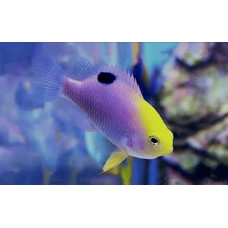Latin name
Chrysiptera talboti
Other name
Talbot's demoiselle
Identification
The species is named after the fisheries scientist Frank H. Talbot, director of the Australian Museum in Sydney, a collector of the species.
Features of fish fins
Dorsal spines (total): 13; Dorsal soft rays (total): 11 - 12; Anal spines: 2; Anal soft rays: 11 - 13.
Fish colouring
Talbot's damselfish has a yellow head, yellow pelvic fins and a large black spot on the back of the dorsal fin.
Distribution
Widespread throughout the western Pacific: Andaman Sea in the eastern Indian Ocean to Fiji, north to Palau, south to the southern Great Barrier Reef. Recently recorded from Tonga.
Habitat
Marine tropical species. Adults inhabit coral-rich areas on seaward reef slopes and deep lagoons. Depth ranges from 3 to 35 meters.
Size
These fish reach six centimeters (2.4 inches) in length.
Behavior
These fish are usually found alone on coral and gravel areas. A diurnal species. Does not migrate.
Food and feeding habits
Feed on zooplankton close to the bottom.
Reproduction
Egg-laying, mating during reproduction. Eggs are on the bottom and attached to the substrate. Males guard and aerate eggs.
Fishing
This species has little commercial value. They are sometimes caught for sale to aquariums.
Relationship with a person
Harmless. In the aquarium, this species leads a peaceful lifestyle, showing cowardice when confronted with more aggressive congeners.
| Classification | |
| Phylum | Chordata |
| Class | Actinopterygii |
| Family | Pomacentridae |
| Genus | Chrysiptera |
| Species | C. talboti |
| Features | |
| Conservation status | Least Concern |
| Habitat | Pelagic |
| Life span, years | No information |
| Maximum body weight, kg | No information |
| Maximum length, cm | 6 |
| Sailing speed, m/s | No information |
| Threat to people | Not edible |
| Way of eating | Planktonophage |
Talbot's damselfish
Tags: talbots damselfish



